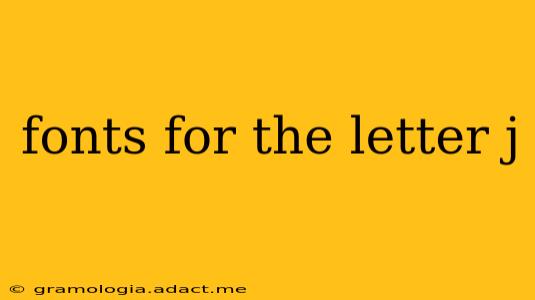The humble letter "J" – often overlooked, yet crucial to the flow and feel of any typeface. While you might not consciously think about it, the design of the "J" significantly impacts the overall aesthetic of a font. From elegant swirls to bold strokes, the variations are vast and captivating. This guide explores the diverse world of fonts and their unique interpretations of the letter "J," helping you find the perfect font for your next project.
What Makes a "J" Unique in Different Fonts?
The "J" is a fascinating letter because its design often acts as a microcosm of the font's overall style. A serif font might present a "J" with a graceful serif at the base, mirroring the details found throughout the typeface. Sans-serif fonts, conversely, tend to feature a more minimalist "J," often a clean curve connecting to a straight stem. The variations are truly endless, with some fonts displaying a dramatic flourish, while others remain simple and understated. The "J" can be a defining characteristic of a font's personality.
Fonts Known for Their Beautiful J's: Examples & Styles
While subjectivity plays a role in aesthetics, some fonts are consistently praised for their elegant and well-designed "J"s. Let's explore a few examples and their stylistic characteristics:
-
Traditional Serifs: Fonts like Garamond and Times New Roman feature classic, refined "J"s that blend seamlessly with the overall traditional feel. These "J"s typically possess a gentle curve and a subtle serif at the base, embodying timelessness and elegance.
-
Modern Serifs: Playfair Display showcases a more assertive, yet still refined "J." It strikes a balance between traditional elegance and contemporary boldness.
-
Sans-Serifs: Helvetica and Arial exemplify simplicity with their clean and geometric "J"s, reflecting the clean lines and minimalist aesthetic of the font families. These "J"s are functional and versatile, suitable for various applications.
-
Script Fonts: Script fonts offer a much wider range of "J" design interpretations. Some may feature a dramatic flourish, while others are more restrained and elegant. The specific "J" heavily depends on the individual script font selected.
What are some common characteristics of well-designed J's?
A well-designed "J" – regardless of font style – should be legible and easily distinguishable from other letters. This means clear distinction between the hook and the stem, avoiding confusion with the letter "U" or "g." Proportion is also key. The "J" should be well-balanced in relation to other characters within the font, maintaining visual harmony. Finally, the design should be consistent with the overall aesthetic of the typeface.
How to Choose the Right Font with the Perfect "J" for Your Project?
Choosing the perfect font depends largely on the project's context. Consider these factors:
-
Purpose: A formal document might require a traditional serif with a refined "J," while a playful poster could benefit from a script font with a more dramatic "J."
-
Readability: Prioritize legibility, especially for large blocks of text. Avoid overly stylized "J"s that might compromise readability.
-
Overall Aesthetic: The "J" should align with the overall style and mood you aim to create.
What other aspects of typeface design should I consider beyond the "J"?
While the "J" can be a great indicator of a font's character, remember to consider the entire alphabet's design consistency, x-height, kerning, and overall readability. A beautifully designed "J" doesn't necessarily guarantee a superb font overall.
By carefully considering these points, you can select the perfect font—one that not only boasts a stunning "J" but also effectively enhances your project's visual appeal and communicates the intended message. The "J" may be a small letter, but its design speaks volumes about the overall typeface.
